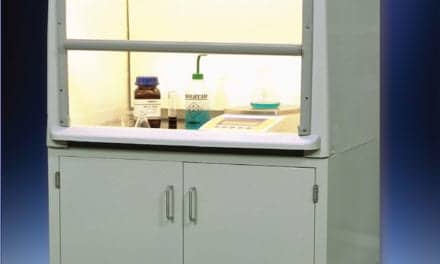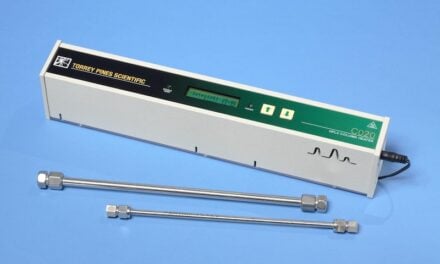The restructuring of workflow among laboratory sites, coupled with the constant concern of decreased Medicare reimbursements, led Affiliated Laboratory, Inc. of Bangor and Portland, Me., to look for ways to boost lab personnel efficiency. Affiliated is an independently owned and operated laboratory located within the Eastern Maine Medical Center (EMMC) in Bangor. It performs clinical testing services for EMMC and other facilities throughout northern New England. The emphasis was on finding more efficient ways for technologists to perform routine tasks, which would allow them more time for performing clinical assays. Quarterly pipette calibration checks were one area targeted as very time consuming.
 Chemistry Lab Supervisor Cheryl Mowery
Chemistry Lab Supervisor Cheryl Mowery
reviews calibration records.
Automated pipette calibration
The chemistry was right for switching to colorimetric pipette calibration.
As a Chemistry Laboratory Supervisor at Affiliated Laboratory, Inc. in Bangor, Maine, I am responsible for providing reliable clinical assay results, minimizing expense and waste and maximizing efficiency. In practical terms, my job is to create an environment where skilled laboratory technologists spend the majority of their valuable time focused on patient testing. Pipette calibration and maintenance, always a persistent drain on technologist time, was one of the tasks I was looking to streamline.
After investigating the three methods used to calibrate pipettes, gravimetric, titrametric, and colorimetric, it was clear that the colorimetric method was the simplest. I chose the colorimetric Artel Pipette Calibration System (PCS) because it offered efficiency, accuracy and cost effectiveness. The automated PCS was easy to learn and use, took significantly less technologist time and could be shared with other lab departments at the EMMC campus and with our other lab site in Bangor and our Portland lab.
Changing any laboratory procedure, even a minor one, can be disruptive. I was concerned that changing the way we calibrated our pipettes might involve significant time spent re-training lab personnel. When we expressed our concerns to the people at Artel, they set up a 30-minute training session for our labs. The session included not only a discussion of the PCS operation, but also a brief review of proper pipetting technique. The PCS demonstration further convinced me and the attending technologists that we had made the right decision. The PCS was considerably more easy-to use than the titration method we had been using. The responsive customer service and support provided by Artel also factored into our decision.
From the moment we set up and starting using the PCS in the chemistry department, our way of thinking about calibrating pipettes changed. What had been a tedious and time consuming chore became quick, easy and even (hard to believe) enjoyable. The instrument’s prompt screen takes you step-by-step through the simple procedure. It indicates which dye solution to use, and at the end of a run, the instrument automatically calculates and prints data, such as the percent CV and the percent inaccuracy, for each pipette.
We now can check all 20 of our pipettes in less than an hour using five data points per volume for each pipette. That compares to the four to five hours or more to take two data points per volume using the titration method. In chemistry alone, that represents three to five additional hours each quarter that technologists can devote to patient testing. Also, the five-point data check is more statistically valid, therefore, we are confident that our pipettes are accurate.
During our quarterly pipette calibration checks, we occasionally find a pipette that does not meet our tolerance limit of 5 percent inaccuracy and 2 percent imprecision. Because it takes less than three minutes to do a five data point re-check using the Artel PCS (compared to 20 minutes with titration), we are much more willing to adjust and recheck the pipettes until we are satisfied that they are calibrated properly.
 Medical Technologist Tina Rawcliffe (left), who checks the pipettes in the chemistry department, is an enthusiastic PCS convert. “The Artel system has made checking pipettes incredibly easy and fast,” she said. “I now can do a quick check whenever a pipette is suspect as opposed to putting it in a drawer and waiting for the next scheduled check.”
Medical Technologist Tina Rawcliffe (left), who checks the pipettes in the chemistry department, is an enthusiastic PCS convert. “The Artel system has made checking pipettes incredibly easy and fast,” she said. “I now can do a quick check whenever a pipette is suspect as opposed to putting it in a drawer and waiting for the next scheduled check.”
Although it is difficult to put a dollar value on having more accurate pipettes, the willingness of technologists to do these spot checks on suspect pipettes in addition to having more statistically valid scheduled checks, has increased the overall reliability of our patient testing.
Chemistry is not the only department using the PCS. We are sharing it with the blood bank and hematology/ co-ag departments, each of which has at least as many pipettes to be calibrated as chemistry. PCS has been a big hit in these areas as well.
Until recently, Eugene Rioux, a medical technologist, was responsible for checking pipettes for the blood bank. He found the PCS easy to set-up and use. “The manual is easy to follow even for someone not familiar with the instrument,” Rioux said. “I also like that the system can perform calculations immediately with the option to accept or edit data as needed.”
The PCS integrated easily into Affiliated Lab’s EMMC site, as well as the Union Street and Portland sites. A padded metal suitcase, which holds the colorimeter, printer, cables, reagents and manual, transports the system to other sites. The first time the PCS was sent to our Portland lab, it arrived without any instructions. The tech there was able to set up and use the PCS after referring to a laminated Quick Start Card with brief instructions. Portland’s transition to the automated pipette calibration system went smoothly and has produced similar savings in time and effort. We now routinely ship the PCS among all Affiliated Lab’s sites.
All in all, I feel that we got far more than we bargained for by switching to an automated pipette calibration system. We immediately reduced the time spent calibrating chemistry pipettes by 75 percent and soon realized similar time savings in the other departments and sites as well. This was accomplished with minimal time spent re-training technologists in operating the new system. The speed and ease-of-use of the Artel PCS enabled us to take more data points per pipette, and the technologists are now willing and able to do spot checks any time a pipette is suspected of being out of specification. This has resulted in more accurate pipettes, more reliable patient testing, and a more efficient laboratory.
Cheryl Mowery is chemistry laboratory supervisor at Affiliated Laboratory Inc., Bangor, Maine.




